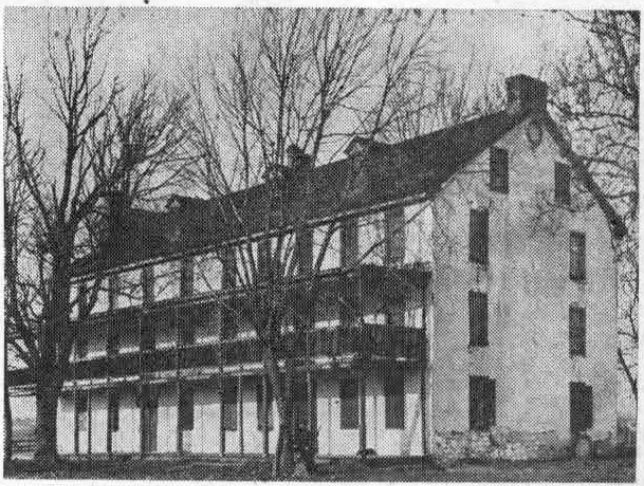 Several months ago this writer received from Concord, Calif., the 50-year-old picture used in last week’s column, showing the old Gallagher house, which, up until a short time ago, stood on the south side of Lancaster avenue where it is joined by Conestoga road. With the picture was a letter from Mrs. Isabel Gallagher Lyons, who, though she has not lived in this section for some years, is still a subscriber to “The Suburban” and a reader of this column. The letter reads, in part:
Several months ago this writer received from Concord, Calif., the 50-year-old picture used in last week’s column, showing the old Gallagher house, which, up until a short time ago, stood on the south side of Lancaster avenue where it is joined by Conestoga road. With the picture was a letter from Mrs. Isabel Gallagher Lyons, who, though she has not lived in this section for some years, is still a subscriber to “The Suburban” and a reader of this column. The letter reads, in part:
“For your section ‘Your Town and My Town,’ perhaps the photograph which I am sending herewith may be of some interest. This house was the residence of my parents, Mr. and Mrs. John M. Gallagher, of Lancaster and Conestoga roads, Wayne. The picture was taken about 1905. The corner was sold two years ago to the Gulf Refining Company for a gas station.
In the days of George Washington there was an Inn called ‘The Unicorn’ on this corner. Across the way the ‘Spread Eagle Inn’ housed Washington’s troops on their march along Conestoga road from Philadelphia to Valley Forge, while in the ‘Unicorn’ the English troops made their headquarters. The ‘Unicorn’ was later burned down. On its former site a residence was erected in the era when the houses on Bloomingdale avenue were built with their flat roofs, ten-foot high ceilings, long front windows and almost surrounded by porches.”
In a later letter, Mrs. Lyons has written:
“My grandfather, Edward Gallagher, bought the farm which included the large Brooks Parker field across the Pike, all along Conestoga road and along South Devon avenue to the top of the hill where the DeSchaunsee home is, for the now unbelievable price or $75 per acre. Now the selling price is around $200 per front! The house, recently torn down, in which our family lived, was on the property when my grandfather bought it, according to stories my mother told me (and they were as good as any stories!). She said one former owner had been the Chew family… they used it for a summer home only. For in those days Strafford was a summer resort… the house was very cool with its 12-inch stone walls. I never heard from whom my grandfather purchased it.”
For many years the Gallagher family has been well known throughout this entire section. The Bateman-Gallagher Post is named in part for a son, Edward Gallagher, who lost his life ln World War I. Mr. Gallagher was a prominent business man, being at one time the president of the Radnor Building & Loan Association. Mrs. Gallagher was not only the organizer and first president of the national Gold Star Mothers, but she was also instrumental in starting the Pennsylvania Chapter of War Mothers.
When the Gallagher house was built, the famous old Spread Eagle Inn, which had stood almost across the Pike, had just been destroyed, or perhaps was just about to be destroyed. As reported in last week’s column, the inn’s last owner, George W. Childs, used the stone in it for the Bloomingdale avenue houses, possibly even some of it for the very house that was about to be constructed at the intersection of Conestoga road and the Pike.
Built in 1796, the handsome four story stone building pictured above, with porches extending along the entire front, replaced a crude little structure of the same name which had been among the first of many inns to be built along the old turnpike.
Sixty-seven taverns lined the 62 miles of this turnpike before the Philadelphia and Columbia railroad was completed by the Canal Commission in 1820. With the coming of the railroad the stage coach travel along Lancaster Pike decreased until there was need for only the more spacious and better equipped inns. Some, however, and particularly those close to Philadelphia, remained open as summer boarding houses, as did the Spread Eagle for a number of years.
Of the gay days at an inn, J. F. Sachse in his delightful book, “Wayside Inns on the Lancaster Turnpike,” writes:
“Within the tavern all would be life and animation. On warm, fair nights, the porch as well as the piazza above was illuminated by large reflecting lamps, when on such occasions congregated the ladies and gentlemen who were stopping there, either permanently or temporarily, to while away the time and watch the life and bustle on the road in front of the Inn, as well as in the yard beyond. The shouts and activity of the hostlers and stablemen at the arrival or departure of the mail or post coach, the rapidity with which the horses were unhitched, or replaced by fresh relays after the passengers had refreshed themselves, the numbers of travelers on horseback or in private conveyances, the occasional toot of a stage horn or ring of the hostlers bell – all tended to form a continuous change of scene.”
It is a far cry from a description of such a scene to another, written by the same author in 1886 when he says, ”The old inn, though in good repair, is closed and without an occupant, and looms on the roadside like a dark and sombre relic of the past, with nothing to remind the present generation of its departed glories.”
It was then that it was torn down by order of Mr. Childs.
